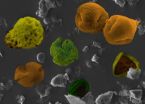(Press-News.org) The laboratory of Huda Zoghbi, where the discovery that mutations in the gene MECP2 cause the severe childhood neurological disorder Rett Syndrome was made, has taken yet another step toward unraveling the complex epigenetic functions of this gene, implicated also in cases of autism, bipolar disease and childhood onset schizophrenia. The November 11 issue of Nature reports that removing MECP2 from a small group of neurons that typically make the inhibitory neurotransmitter, GABA, recapitulates many symptoms of Rett as well as numerous neuropsychiatric disorders.
The identification of the genetic basis of Rett allowed the development of a number of mouse models of the disorder, accurately reproducing the range of symptoms seen in humans. These are considered to be among the best existing models of neurological disease.
While removing MECP2 from every cell results in full-blown Rett symptoms, the Zoghbi lab during the past few years has been using genetic tools to knock out the gene from distinct subsets of specialized brain cells called neurons, in an attempt to correlate certain neuronal populations with specific symptoms.
GABA (gamma amino butyric acid) is the main inhibitory neurotransmitter in the brain. Neurons releasing GABA regulate the nervous system by acting like traffic lights on the brain's information highway. Zoghbi and Hsiao-Tuan Chao, a postdoctoral fellow in the lab and lead author of the study, use this analogy to describe the action of GABA in allowing for a balanced level of neuronal activity by controlling the strength and timing of information transfer. Surprisingly, Zoghbi, Chao and colleagues found that removing MeCP2 from the small number of GABA-producing neurons reduced production of the neurotransmitter by about 30%. This reduction reproduced many symptoms of Rett including the paw-clasping that mimics the classical hand-wringing stereotypies. After a brief period of apparently normal development, the mice display brain hyperexcitability, impaired respiration, and loss of muscle control and strength and premature lethality. Learning, memory and sensory responses are also altered. Interestingly, the mice engaged in repetitive movements reminiscent of compulsive behavior seen in a number of neuropsychiatric disorders.
The study raises a number of important points. It implicates GABA as a key player in Rett and suggests that boosting the activity of GABA producing neurons may help to alleviate the severity of some symptoms. It also begs the question: If a 30% reduction in GABA causes Rett symptoms, could a more subtle perturbation of 10% or 20% lead to certain neuropsychiatric disorders? This study suggests a possible pathway which can now be explored to answer the question fully.
"This study revealed to us the critical role of MECP2 in modulating the levels of GABA in inhibitory neurons and pinpointed all the neuropsychiatric symptoms that develop when the function of inhibitory neurons is compromised. Identifying the cellular and chemical basis of such symptoms is a first step in efforts aimed at understanding and, one day, treating such disorders," said Zoghbi.
Dr. Zoghbi, who was first drawn into Rett research through her clinical experience at Baylor College of Medicine, is a Howard Hughes investigator and a Rett Syndrome Research Trust Scientific Advisor.
Monica Coenraads, Executive Director at the Rett Syndrome Research Trust which helped to fund this work, says "The field of Rett research has benefited incalculably from Huda Zoghbi's dedication and perseverance. Her latest results suggest that GABAergic pathways are ripe for exploration not only as therapeutic intervention for Rett Syndrome but also for a much wider class of neurological disease."
INFORMATION:
About Rett Syndrome
Rett Syndrome strikes little girls almost exclusively, with first symptoms usually appearing before the age of 18 months. These children lose speech, motor control and functional hand use, and many suffer from seizures, orthopedic and severe digestive problems, breathing and other autonomic impairments. Although some victims of Rett Syndrome do not survive childhood, most live to become adults who require total, round-the-clock care.
About Rett Syndrome Research Trust
The Rett Syndrome Research Trust is the premier organization devoted exclusively to promoting international research on Rett Syndrome and related MECP2 disorders. The goal is clear: to heal children and adults who will otherwise suffer from this disorder for the rest of their lives. With experience and tight focus, RSRT has an unparalleled knowledge base and extensive networking abilities in the world of high level research. RSRT is in a unique position to stimulate, evaluate, support and monitor ambitious and novel scientific projects. www.reverserett.org
About Baylor College of Medicine
Baylor College of Medicine (www.bcm.edu) in Houston is recognized as a premier academic health science center and is known for excellence in education, research and patient care. It is the only private medical school in the greater southwest and is ranked as one of the top 25 medical schools for research in U.S. News & World Report. BCM is listed 13th among all U.S. medical schools for National Institutes of Health funding, and No. 2 in the nation in federal funding for research and development in the biological sciences at universities and colleges by the National Science Foundation. Located in the Texas Medical Center, BCM has affiliations with eight teaching hospitals, each known for medical excellence. Currently, BCM trains more than 3,000 medical, graduate, nurse anesthesia, and physician assistant students, as well as residents and post-doctoral fellows. BCM is also home to the Baylor Clinic, an adult clinical practice that includes advanced technologies for faster, more accurate diagnosis and treatment, access to the latest clinical trials and discoveries, and groundbreaking healthcare based on proven research.
END
Millions will escape hunger and poverty in a widening campaign to achieve global food security and deliver major environmental gains within 25 years
Hanoi, Vietnam – One of the world's largest global scientific partnerships for sustainable agricultural development has launched a bold new research initiative that aims to dramatically improve the ability of rice farmers to feed growing populations in some of the world's poorest nations. The efforts of the Global Rice Science Partnership, or GRiSP, are expected to lift 150 million people out of poverty by 2035 and prevent ...
LA JOLLA, CA—A collaborative effort between researchers at the Salk Institute for Biological Studies and the University of California, San Diego, successfully used human induced pluripotent stem (iPS) cells derived from patients with Rett syndrome to replicate autism in the lab and study the molecular pathogenesis of the disease.
Their findings, published in the Nov. 12, 2010, issue of Cell, revealed disease-specific cellular defects, such as fewer functional connections between Rett neurons, and demonstrated that these symptoms are reversible, raising the hope that, ...
WHAT:
The 2010 Annual Meeting of the American College of Allergy, Asthma & Immunology (ACAAI) brings together leading allergists and immunologists from around the world.
WHO:
Scientists supported by the National Institute of Allergy and Infectious Diseases (NIAID), part of the National Institutes of Health, will present their latest research findings at the ACAAI Annual Meeting. For more than 60 years, NIAID has supported allergy and immunology research at U.S. and international institutions and conducted studies within its own laboratories to improve the health ...
Using induced pluripotent stem cells from patients with Rett syndrome, scientists at the University of California, San Diego School of Medicine have created functional neurons that provide the first human cellular model for studying the development of autism spectrum disorder (ASD) and could be used as a tool for drug screening, diagnosis and personalized treatment.
The research, led by Alysson R. Muotri, PhD, assistant professor of pediatrics, will be published in the November 12 issue of the journal Cell.
"This work is important because it puts us in a translational ...
The presence of certain markers in the urine might be a red flag for acute kidney injury (AKI), according to a study appearing in an upcoming issue of the Journal of the American Society Nephrology (JASN). The results suggest that a simple urine test could help prevent cases of kidney failure.
Unlike heart or brain injuries, which show obvious outward signs, physical symptoms are not typically present with AKI. Researchers have been looking for markers of AKI, with the hope that early detection will lead to early therapy to prevent kidney failure. Richard Zager, MD (Clinical ...
Researchers in France have uncovered a mechanism which explains how biological clocks accurately synchronize to the day/night cycle despite large fluctuations in light intensity during the day and from day to day. Following the identification of two central "clock genes" of a green alga, Ostreococcus tauri, a mathematical model reproducing their daily activity profiles has revealed that their internal clock is influenced by the naturally varying light levels throughout the day only at periods when it needs resetting. The results found by the biologists at Oceanologic Observatory ...
CAMBRIDGE, Mass. — Cat fanciers everywhere appreciate the gravity-defying grace and exquisite balance of their feline friends. But do they know those traits extend even to the way cats lap milk?
Researchers at MIT, Virginia Tech and Princeton University analyzed the way domestic and big cats lap and found that felines of all sizes take advantage of a perfect balance between two physical forces. The results will be published in the November 11 online issue of the journal Science.
It was known that when they lap, cats extend their tongues straight down toward the bowl ...
PHILADELPHIA—An international team of scientists, including a leading evolutionary biologist from the Academy of Natural Sciences, have reset the agenda for future research in the highly diverse Amazon region by showing that the extraordinary diversity found there is much older than generally thought.
The findings from this study, which draws on research by the Academy's Dr. John Lundberg and other scientists, were published as a review article in this week's edition of Science. The study shows that Amazonian diversity has evolved as by-product of the Andean mountain ...
The steamiest places on the planet are getting warmer. Conservative estimates suggest that tropical areas can expect temperature increases of 3 degrees Celsius by the end of this century. Does global warming spell doom for rainforests? Maybe not. Carlos Jaramillo, staff scientist at the Smithsonian Tropical Research Institute, and colleagues report in the journal Science that nearly 60 million years ago rainforests prospered at temperatures that were 3-5 degrees higher and at atmospheric carbon dioxide levels 2.5 times today's levels.
"We're going to have a novel climate ...
CAMBRIDGE, Mass. -- People spend 46.9 percent of their waking hours thinking about something other than what they're doing, and this mind-wandering typically makes them unhappy. So says a study that used an iPhone web app to gather 250,000 data points on subjects' thoughts, feelings, and actions as they went about their lives.
The research, by psychologists Matthew A. Killingsworth and Daniel T. Gilbert of Harvard University, is described this week in the journal Science.
"A human mind is a wandering mind, and a wandering mind is an unhappy mind," Killingsworth and ...


